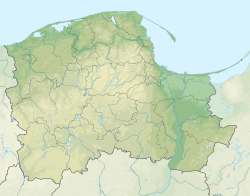Great stone graves near Dąbrówno
| Great stone graves near Dąbrówno Large stone graves near Schöneichen | ||
|---|---|---|
|
|
||
| Coordinates | Dąbrówno 1 , Dąbrówno 2 | |
| place | Gmina Potęgowo OT Dąbrówno , Pomerania , Poland | |
| Emergence | 3500 to 2800 BC Chr. | |
| Sprockhoff no. | 585-586 | |
The megalithic graves near Dąbrówno (also called megalithic graves near Schöneichen ) are two megalithic tombs of the Neolithic funnel cup culture at Dąbrówno ( German Schöneichen ), a district of Gmina Potęgowo (German Prillwitz ) in the Pomeranian Voivodeship in Poland . They have the Sprockhoff numbers 585 and 586.
location
The graves are located 500 m east of the former Schöneichen estate. Grave 2 is only 14 m southeast of grave 1. 2.3 km south-southwest are the megalithic graves near Łupawa (megalithic graves near Lupow).
description
Grave 1
The complex originally had a pile of mounds of which only remains are left. A stone enclosure never seems to have existed. The burial chamber is oriented approximately east-west and has a length of 3 m and a width of 1 m. It originally consisted of four pairs of wall stones on the long sides and one end stone each on the narrow sides. The end stones and three wall stones on the south side are in situ . Two wall stones on the north side have been dragged north. The remaining wall stones and all cap stones are missing. Two larger explosives could represent the remains of capstones. It is unclear where the original access to the chamber was. It is therefore not certain whether the complex can be referred to as a large dolmen or a passage grave. When he was admitted in 1934, Ernst Sprockhoff discovered that the chamber had been ransacked. He found numerous ceramic shards in the area around the grave.
Grave 2
This complex originally had a mound of which remains can still be seen. A stone enclosure never seems to have existed. The badly damaged burial chamber is oriented east-northeast-west-southwest and has a length of 1.8 m and a width of 0.9 m. It originally consisted of two pairs of wall stones on the long sides, one end stone each on the narrow sides and two cap stones. It can therefore be referred to as an extended dolmen . There are only three stones left. The western wall stone on the south side is still in situ. The other two stones are relocated wall stones.
literature
- Hans Jürgen Eggers (Ed.): Pomeranian finds and excavations from the 30s and 40s. Table volume (= Atlas of Prehistory. Supplement 10). Hamburg Museum of Ethnology and Prehistory, Hamburg 1964, plates 61, 66.
- Ernst Sprockhoff : Atlas of the megalithic tombs of Germany. Part 2: Mecklenburg - Brandenburg - Pomerania. Rudolf-Habelt Verlag, Bonn 1967, pp. 98-99.
